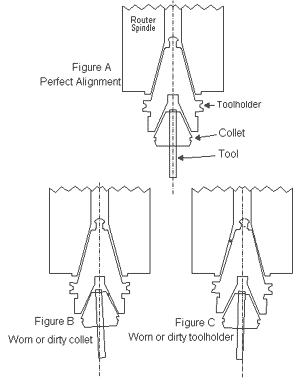Question
I use a Komo Mach III and have been cutting an exterior grade MDF called Medex. I broke a 5/8 chip/finisher going 17000 rpm with a feedrate of 500in/min cutting .5 inch. Before that, I broke a 1/2 chipbreaker trying to cut the 3/4 stock in one pass. Any suggestions?
Forum Responses
Everything else being equal with successful cutting on other products, I'd suggest taking a good look at hold down. If this is a new material to you, make sure you are getting no material slippage or vibration.
My experience is with odd shaped hardwood components on vac pods. What I've learned is I snap bits when I set up in such a way as to allow the wood to vibrate a bit under cutting pressure. This will almost always result in a bit snap.
Router spindles, toolholders and collets are made with matching tapers that, when clean and new, will keep the tool centered in the spindle. Any tiny amount of debris (like sawdust) that interferes with the mating of these tapers will cause the tool to "run out", or turn off-center. In turn, this will lead to vibration, poor finish, poor tool life, possibly tool breakage and spindle damage.
The amount of wear that causes a toolholder or collet to be worn is invisible to the naked eye. That's why I recommend replacing a collet that has been in daily every 6 months, or a toolholder after a year. If a tool ever slips in a collet, replace it immediately. The drawings below show a tool with run-out equal to the radius of the bit. This is obviously enhanced to demonstrate a point. It only takes .002" run out at the tool tip to ruin a tool's performance.
When you change a tool, completely disassemble the collet and nut, and use a solvent to clean all the parts, including the tool shank before re-assembly.

Editor's Note: Southeast Tool (website) is a leading provider of woodworking router bits, solid carbide spirals, and tooling.